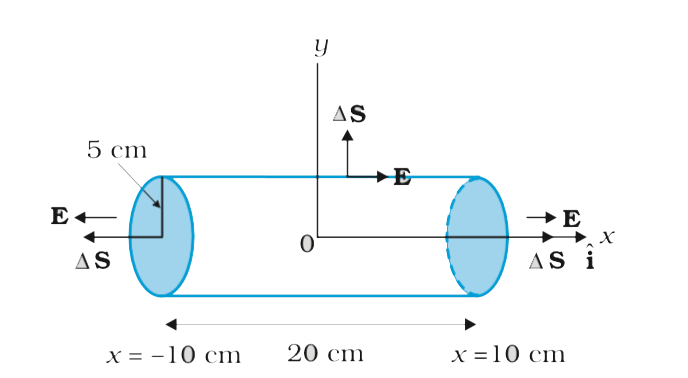An electric field is uniform, and in the positive x-direction for positive x, and uniform with the same magnitude , but in the negative x-direction for negative x. It is given that
→E=200ˆiN/Cforx>0and→E=−200ˆiN/C for x<0. A right circular cylinder of length 20 cm and raidus 5cm has its center at the origin and its axis along the x-axis so that one face is at x=+10cm and the other is at x=−10cm.
(a) What is the net outward flux through the side of the cylinder ? (b) What is the net outward flux through the cyclinder ? (c) what is net charge inside the cylinder ?
(a) We can see from the figure that on the left face E and DS are
ϕL=EΔS=−200ˆi−ΔS
=+200ΔS,sinceˆiΔS=−ΔS
=+200×π(00.052)=+1.57Nm2C−1
On the right point face E and ΔS are parallel and therefore
ϕR=E.ΔS=+1.57Nm2C−1.
(b) For any point on the side of the cylinder E is perpendicular to ΔS and hence E.ΔS=0. Therefore, the flux out of the side of the cylinder is zero.
(c) Net outward flux through the cylinder
ϕ=1.57+1.57+0=3.14Nm2C−1

(d) The net charge within the cylinder can be found by using Gauss’s law which gives
q=ε0ϕ
=3.14×8.854×10−12C
2.78×10−11C .
Topper's Solved these Questions
- ELECTRIC CHARGES AND FIELDSBOOK - NCERTCHAPTER - ELECTRIC CHARGES AND FIELDSEXERCISE - EXERCISE
34 Videos
- DUAL NATURE OF RADIATION AND MATTERBOOK - NCERTCHAPTER - DUAL NATURE OF RADIATION AND MATTEREXERCISE - Exercise
37 Videos
- ELECTROMAGNETIC INDUCTIONBOOK - NCERTCHAPTER - ELECTROMAGNETIC INDUCTIONEXERCISE - Exercise
17 Videos
Similar Questions
An electric field is uniform and in the positive x direction for positive x and uniform with the same magnitude but in the negative x direction for negative x. It is given that E=200ˆiN/C for x>0 and E=−200ˆiN/C for x<0. A right circular cylinder of length 20 cm and radius 5 cm has its centre at the origin and its axis along the x-axis so that one face is at x=+10 cm and the other is at x=−10 cm
What is the flux through the side of the cylinder?
View Solution(a) Using Gauss law, derive expression for electric field due to a spherical shell a uniform charge distribution σ and radius R at a point lying at a distance r from the centre of shell, such that
(i) O<r<R,and
(ii) r>R.
(b) An electric field is uniform and acts along +x direction in the region of positive x. It is also uniofrm with the same magnitude but acts in -x direction in the region of negative x. The value of the fleld is E= 200 N/C for x>0andE=−200N/C for x<0. A right circular cylinder of length 20 cm and radius 5 cm has its centre at the origin and its axis along the x-axis so that one flat face is at x =+ 10 cm and the other is at x=-10 cm.
Find :
(i) The net outward flux through the cylinder.
(ii) The net change present inside the cylinder.
View Solution
Knowledge Check
The electric field in a region is given by →E=200ˆiN/C for x>0 and −200ˆiN/C for x<0. A closed cylinder of length 2m and cross-section area 102m2 is kept in such a way that the axis of cylinder is along X-axis and its centre coincides with origin. The total charge inside the cylinder is (Take e0=8.25×10−12C2m2.N)
AzeroB1.86×10−5CC1.77×10−11CD35.4×10−8CA unifrom electric field having a magnitude E0 and direction along the positive X-axis exists. If the protential V is zero at x=0, then its value at X=+x will be
AV(x)=−E0x22BV(x)=E0x22CV(x)=−E0x2DV(x)=E0x2If →A=3ˆi−4ˆj and →B=2ˆi+16ˆj then the magnitude and direction of →A+→B will be
A5,tan−1(12/5)B10,tan−1(5/12)C13,tan−1(12/5)D12,tan−1(5/12)
A uniform electric field →E=−ExˆiN/C for x<0 exists. A right circular cylinder of length lcm and radius rcm has its centre at the origin and its axis along X-axis. Find out the net outward flux. What is the net charge within the cyclinder ?
View SolutionLet there be a uniform electric field "E" existing along the positive X-direction.Assume electric potential to be zero at the origin.Potential at the point x=x0 is
View SolutionA vector vec Awhenadded→the→−−→r vec B = 3. 0 hat i+ 4 hat jyieldsarestant–––––→−−→rtˆis∈thepositivey−directionandhasamagn∫udeequal→tˆof vec B.F∈dthemagnitudeof vec A .
View SolutionA charged particle has acceleration →a=2ˆi+xˆj in a megnetic field →B=−3ˆi+2ˆj−4ˆk. Find the value of x.
View SolutionCharge Q is given a displacement →r=aˆi+bˆj in an electric field →E=E1ˆi+E2ˆj. The work done is.
View Solution
